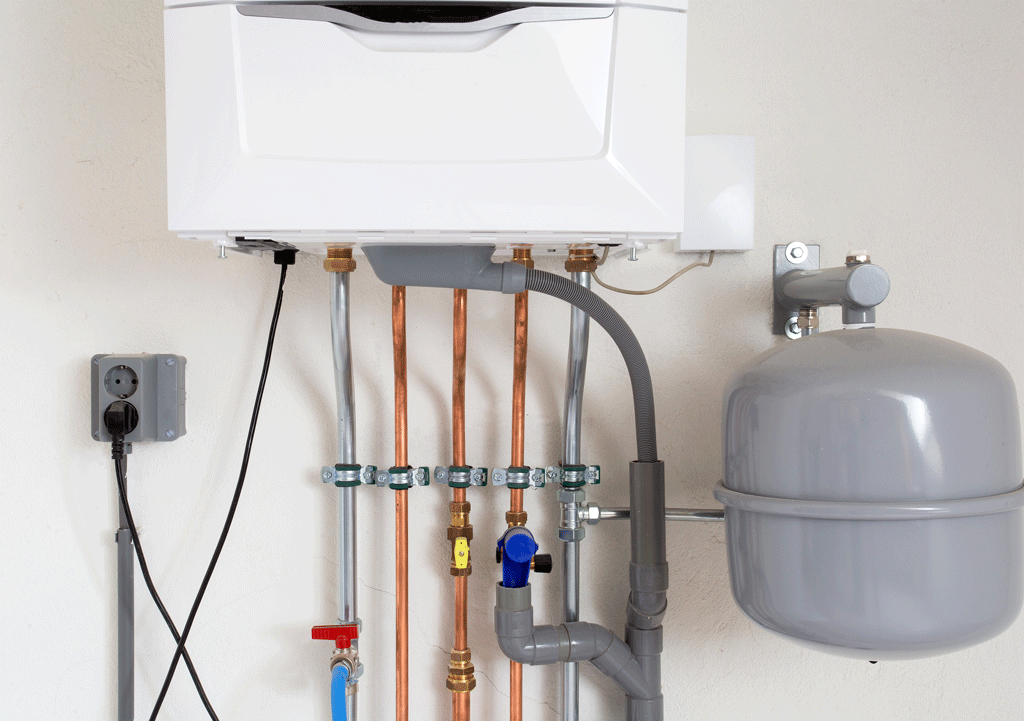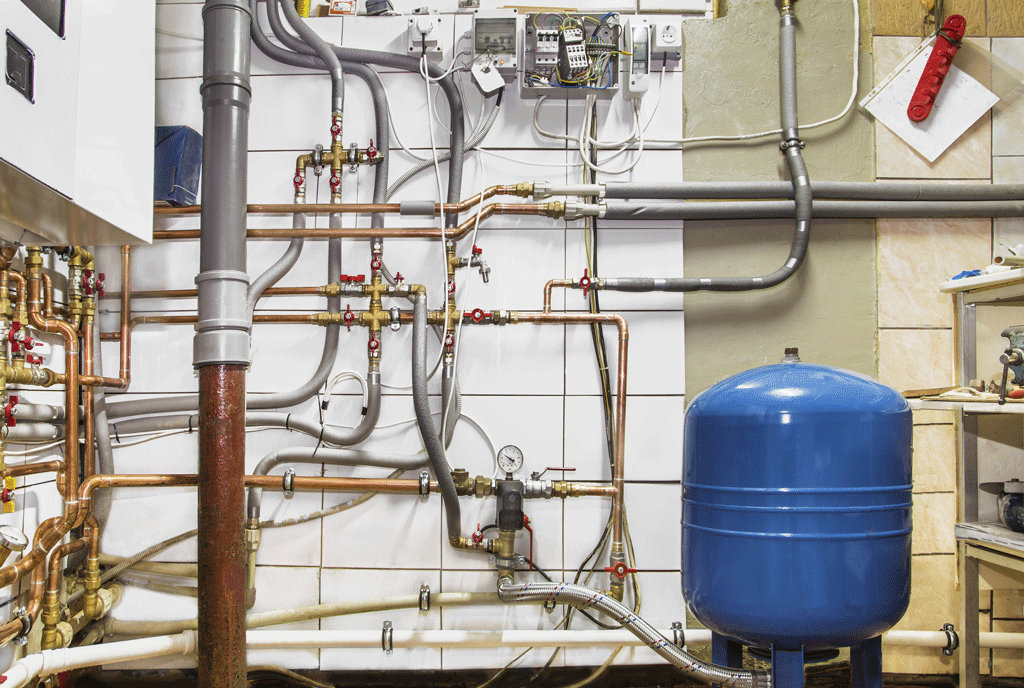Revolutionize Your Plumbing: The Essential Expansion Tank Guide

Have you ever wondered how to maintain a stable and efficient plumbing system in your home?
As a homeowner, understanding the components that make your plumbing system work seamlessly is crucial. One such component, often overlooked but vital, is the expansion tank.
In this article, we delve into the world of tanks, exploring their purpose, benefits, and importance in your home plumbing system.
We’ll guide you through understanding how an expansion tank works, its installation process, and maintenance tips. Whether you’re a seasoned homeowner or new to home maintenance, this guide will equip you with the knowledge to make informed decisions about your plumbing needs.
What is an Expansion Tank?
An expansion tank, a crucial component in modern plumbing systems, particularly in closed water heating systems, plays a vital role in maintaining the integrity and efficiency of your home’s plumbing.
This small but mighty device is designed to absorb excess water pressure, a common issue in many households.
When water is heated in your system, it expands. This phenomenon, known as thermal expansion, can increase water volume significantly. In a closed system, this expansion has nowhere to go, leading to increased pressure.
Over time, this pressure buildup can cause significant stress on your plumbing system, leading to potential damage such as leaks or even burst pipes.
Here’s where the tank comes into play. It acts as a safety net, accommodating the extra volume of water caused by thermal expansion. The tank itself is divided into two sections by a rubber diaphragm.
One side is connected to the plumbing system and is filled with water, while the other side is filled with air. As water expands, it pushes against the diaphragm, compressing the air on the other side. This compression absorbs the excess pressure, preventing it from stressing your plumbing system.
The inclusion of the tank in your plumbing system is not just a matter of efficiency; in many cases, it’s a requirement. Building codes in numerous areas mandate the installation of expansion tanks, especially in systems with a ‘closed loop,’ where backflow into the municipal water system is prevented.
This is because the risks associated with thermal expansion—such as the potential for a water heater to become a pressurized rocket—are significant.
Moreover, the installation of the tank is not a one-size-fits-all solution. Factors such as the size of your water heater and the pressure of your water system influence the type and size of the tank you need.
For instance, larger water heaters or systems with higher pressure will require larger expansion tanks.
In addition to their functional benefits, the tank also contributes to the longevity of your water heater and plumbing fixtures. By mitigating pressure fluctuations, they reduce wear and tear, thereby extending the life of these components.
An expansion tank is a small but essential device in your home’s plumbing system, especially if you have a closed water heating system. Its role in managing the pressure caused by thermal expansion not only protects your plumbing but also ensures the efficient and safe operation of your water heating system.
Whether you’re installing a new system or upgrading an old one, considering the inclusion of the tank is a wise decision for any homeowner.
How Does an Expansion Tank Work?
Understanding the workings of the tank can be quite fascinating. This ingenious device plays a crucial role in preventing damage in your plumbing system by managing the pressure caused by thermal expansion.
Let’s break down the functionality of the tank into more detail.
The Basics of Thermal Expansion
Understanding Thermal Expansion: When water is heated, it expands. This is a natural phenomenon known as thermal expansion.
In a closed plumbing system, this expansion increases water pressure, which, if not managed, can lead to pipe bursts or damage to the water heater.
Role of the Expansion Tank: the tank comes into play by absorbing this extra water volume and pressure, thus protecting your plumbing system from the potential damages caused by thermal expansion.
Components of an Expansion Tank
The tank typically consists of two main components:
The Water Chamber
This is where the expanded water goes. It’s directly connected to the plumbing system.
The Air Chamber
Separated from the water chamber by a diaphragm or bladder, this chamber contains compressed air.
The Working Mechanism
Pressure Absorption
As the water in your system heats up and expands, it flows into the tank. This increased volume of water compresses the air in the air chamber.
Maintaining Pressure Balance
The compressed air in the tank acts like a cushion, absorbing the increased pressure. By doing so, it maintains a balanced pressure within the plumbing system, preventing any damage that could be caused by excess pressure.
Expansion Tank Types and Their Functionality
There are two main types of expansion tanks – diaphragm and bladder tanks – and each works slightly differently:
Diaphragm Tanks
In these tanks, a rubber diaphragm separates the water and air. As water enters the tank, it pushes against the diaphragm, compressing the air on the other side.
Bladder Tanks
These tanks contain a balloon-like bladder that holds the water. The expansion of water compresses the air outside the bladder within the tank.
The Importance of Proper Sizing and Installation
Sizing Matters
For an expansion tank to work effectively, it must be properly sized for your specific plumbing system. This depends on the capacity of your water heater and the pressure of your water system.
Professional Installation
Proper installation is crucial for the functionality of the tank. It should be installed on the cold water supply line near the water heater for optimal performance.
The tank is a vital component in a home plumbing system, ingeniously designed to manage the pressure caused by thermal expansion.
Its ability to absorb excess water volume and maintain pressure balance is crucial in preventing damage to your plumbing system. Understanding how it works, along with ensuring proper sizing and installation, is key to maintaining the health and efficiency of your home’s plumbing.
The Role of Expansion Tanks in Home Plumbing
Expansion tanks are a vital component in ensuring the longevity and efficiency of your home’s plumbing system. Their primary function is to maintain a balanced pressure within the system, safeguarding against the potential damages caused by excessive pressure.
Let’s delve deeper into how the tank contributes to the overall health of your plumbing.
Preventing Damage to Water Heaters and Pipes
The primary role of an expansion tank in your plumbing system is to protect your water heater and pipes from the adverse effects of excessive pressure.
When water is heated in your water heater, it expands, increasing the pressure within your plumbing system. This is where the expansion tank‘s functionality becomes crucial.
Without the tank, the increased pressure has no buffer, leading directly to stress on your water heater and pipes. Over time, this stress can cause leaks or even bursts, leading to costly repairs and potential water damage in your home.
By absorbing the excess pressure, the tank ensures that your water heater and pipes operate within safe pressure levels, significantly reducing the risk of damage.
Enhancing the Efficiency of Your Plumbing System
Another key benefit of having the tank is the enhancement of your plumbing system’s efficiency. By managing the pressure levels within the system, the tank helps maintain a consistent water flow.
This consistency is not only crucial for the longevity of your plumbing but also for the comfort and convenience in your daily water usage.
Expansion Tank Installation: A Crucial Step
The installation of the tank is not just a preventive measure; in many cases, it’s a necessity, especially in homes with closed water heating systems.
Expansion tank installation ensures that your plumbing system complies with local building codes and regulations, which often require such tanks to prevent backflow into the municipal water system.
Choosing the Right Expansion Tank
Selecting the appropriate tank for your home is essential. Factors to consider include the size of your water heater and the pressure of your water system. The right tank should be neither too large nor too small for your system’s capacity.
Consulting with a plumbing professional can help you make an informed decision about the type and size of the tank that best suits your needs.
Long-Term Benefits and Maintenance
Incorporating the tank into your home plumbing system offers long-term benefits. It not only protects your plumbing fixtures but also contributes to their longevity by reducing wear and tear caused by pressure fluctuations.
However, like any other component of your plumbing system, expansion tanks require regular maintenance. This includes checking the air pressure and inspecting for leaks or damage.
Proper maintenance ensures the longevity and efficiency of your plumbing system, including the tank.
The role of the tank in home plumbing is multifaceted. They are essential for preventing damage to water heaters and pipes, enhancing the efficiency of your plumbing system, and ensuring compliance with local building codes.
Choosing the right expansion tank and maintaining it properly are key steps in safeguarding the health of your home’s plumbing system.

Photo By Algirdas Gelazius at Shutterstock
Types of Expansion Tanks
In the realm of home plumbing, understanding the different types of the tanks is crucial for making an informed decision about which is best suited for your system. Primarily, there are two types of expansion tanks: diaphragm tanks and bladder tanks.
Each has unique features and advantages, making them suitable for various plumbing setups.
Diaphragm Expansion Tanks
Diaphragm expansion tanks are characterized by a rubber diaphragm that divides the tank into two sections.
One side of the diaphragm is connected to the plumbing system and holds water, while the other side contains compressed air. The key function of the diaphragm is to absorb the expanded water volume and maintain a balanced pressure within the plumbing system.
Advantages of Diaphragm Tanks
Cost-Effectiveness: Diaphragm tanks are generally more affordable, making them a popular choice for homeowners.
Simplicity in Design: Their simple design makes them easier to install and maintain.
Durability: These tanks are known for their durability and can last for many years with proper maintenance.
Bladder Expansion Tanks
Bladder expansion tanks, on the other hand, feature a balloon-like bladder inside the tank. This bladder holds the water, separating it completely from the air chamber.
When the water expands due to heating, it compresses the air in the chamber outside the bladder, thus maintaining the system’s pressure.
Advantages of Bladder Tanks
Complete Separation: The complete separation of water and air prevents waterlogging and maintains the tank’s efficiency.
Easy Maintenance: Bladder tanks are easier to maintain and replace if needed, as the bladder can be replaced without replacing the entire tank.
Reduced Risk of Corrosion: Since the water is contained within the bladder, there’s a reduced risk of corrosion, which can extend the life of the tank.
Choosing the Right Type for Your Home
The choice between a diaphragm and a bladder tank largely depends on your home’s plumbing system and your specific needs.
Factors such as the size of your water heater, the water pressure in your system, and space considerations will influence your decision.
Space Constraints
If space is limited, a diaphragm tank might be more suitable due to its compact design.
Maintenance Preferences
If ease of maintenance is a priority, a bladder tank might be the better choice.
Budget Considerations
For homeowners working within a budget, diaphragm tanks are often more cost-effective.
Both diaphragm and bladder expansion tanks serve the essential function of maintaining pressure balance in home plumbing systems.
Understanding the unique features and advantages of each type is key to selecting the right tank for your home. Whether you choose a diaphragm or bladder tank, ensuring it matches your system’s requirements will contribute to the efficiency and longevity of your plumbing.
Expansion Tank Installation
Proper installation of the tank is not just a recommendation; it’s a necessity for ensuring the functionality and longevity of your plumbing system. Typically, the tank is installed on the cold water supply line near the water heater.
However, the process involves more than just attaching the tank to the line. Let’s break down the key aspects of tank installation.
Choosing the Right Location
The first step in tank installation is choosing the right location. The most common and recommended spot is on the cold water supply line, close to the water heater. This placement is strategic as it allows the tank to effectively manage the pressure caused by heated water.
Importance of Professional Installation
While some homeowners might consider installing the tank a DIY project, it’s highly recommended to hire a professional. A professional plumber will have the expertise to:
Ensure Correct Sizing: Selecting the right size of the tank is crucial. A professional can accurately calculate the size needed based on your water heater’s capacity and your home’s water pressure.
Guarantee Proper Installation: Proper installation is key to the tank’s functionality. A professional will ensure that the tank is correctly positioned and securely attached to prevent any future issues.
Comply with Local Codes: Professional plumbers are knowledgeable about local building codes and regulations, ensuring that your installation complies with all necessary standards.
Installation Process
The installation process of the tank involves several key steps:
Shutting Off the Water Supply: Before installation, the water supply to the heater must be turned off to prevent any water flow during the process.
Draining Some Water: Draining a small amount of water from the water heater reduces pressure in the system, making installation easier and safer.
Attaching the Expansion Tank: The tank is then attached to the cold water line using appropriate fittings. It’s important to ensure that the tank is securely fastened to avoid any movement.
Checking Air Pressure: The air pressure inside the tank should be checked and adjusted to match the water pressure in your home. This step is crucial for the tank’s effective operation.
Post-Installation Checks
After installation, it’s important to perform a few checks:
Leak Testing: Ensure there are no leaks at the connection points.
Pressure Testing: Verify that the system’s pressure is within safe limits.
Regular Maintenance: Schedule regular checks to ensure the tank remains functional.
The installation of the tank is a critical process that requires precision and expertise.
While it’s possible for a knowledgeable homeowner to undertake this task, the benefits of professional installation—such as ensuring compliance with local codes, correct sizing, and secure attachment—make it a worthwhile investment for the longevity and efficiency of your home’s plumbing system.
Maintenance of Expansion Tanks
Regular maintenance of your tank is crucial for ensuring the longevity and efficiency of your plumbing system.
The tank, being an integral part of your home’s plumbing, requires periodic checks and upkeep to function effectively. Let’s explore the key aspects of maintaining the tank.
Routine Inspection and Air Pressure Check
One of the primary maintenance tasks is the routine inspection of the tank. This involves checking for any signs of wear, leaks, or damage. It’s essential to catch these issues early to prevent more significant problems down the line.
Air Pressure Check: The air pressure inside the tank should be checked at least once a year. The correct pressure level is vital for the tank’s operation and should match the water pressure of your system.
If the air pressure is too low, the tank won’t be able to absorb the excess water pressure effectively. Conversely, too high air pressure can lead to system strain.
Leak Detection and Prevention
Visual Inspection: Regularly inspect your tank for any signs of leaks. Look for water stains or drips around the tank and its connections.
Corrosion Check: Examine the tank for any signs of corrosion, which can lead to leaks and tank failure.
Handling Water Logging Issues
Waterlogging is a common issue with expansion vessels, where the air charge is lost, and the tank fills with water. This can render the tank ineffective and put your system at risk of high pressure.
Draining the Tank: If waterlogging is suspected, the tank may need to be drained and recharged with air. This process involves shutting off the water supply, draining the tank, and then recharging it to the correct air pressure.
Professional Maintenance and Servicing
While some aspects of expansion tank maintenance can be handled by a homeowner, it’s often advisable to seek professional servicing, especially if you’re not comfortable performing these tasks or if your system is complex.
Expert Evaluation: A professional plumber can provide a thorough evaluation of your expansion vessel’s condition and perform any necessary repairs or adjustments.
Comprehensive System Check: Professionals can also assess the overall health of your plumbing system, ensuring that the tank and other components are functioning harmoniously.
Regular maintenance of your expansion vessels is a key aspect of home plumbing care. It involves routine inspections, air pressure checks, leak detection, and handling water logging issues.
For the best results and to ensure the safety and efficiency of your plumbing system, consider enlisting the help of a professional for comprehensive maintenance and servicing. This proactive approach will not only extend the life of your expansion vessels but also safeguard your home against potential plumbing failures.

Photo By SaskiaAcht at Shutterstock
Signs You Need an Expansion Tank
Recognizing the signs that you may need an expansion vessel in your plumbing system is crucial for maintaining the health and efficiency of your home’s water system.
Certain indicators can signal that your system is experiencing thermal expansion issues, which an expansion tank can help resolve.
Let’s explore these signs in more detail.
Fluctuating Water Pressure
Inconsistent Water Flow: One of the most noticeable signs that you might need an expansion vessel is fluctuating water pressure.
If you observe that the water flow in your faucets or shower heads is inconsistent, swinging from high to low pressure, it could be a symptom of pressure buildup in your system.
Impact on Appliances: These fluctuations can also affect household appliances that use water, such as dishwashers and washing machines, potentially reducing their efficiency and lifespan.
Banging Noises in Pipes (Water Hammer)
Identifying Water Hammer: Banging or knocking sounds in your pipes, often referred to as ‘water hammer,’ can indicate that water pressure within your system is too high. This noise occurs when the flow of water is suddenly stopped or changed, causing a shockwave through the pipes.
Potential for Damage: Not only is water hammer disruptive, but it can also lead to damage over time, such as loosened pipe joints or even bursts in extreme cases.
Visible Strain on Plumbing Fixtures
Leakage and Damage: Another sign that your tank might be necessary is visible strain on plumbing fixtures. This can include leaks around pipe connections, particularly near the water heater, or signs of stress on the water heater itself.
Preventing Costly Repairs: Installing your tank can alleviate this strain, potentially preventing costly repairs and extending the life of your plumbing fixtures.
High System Pressure Readings
Monitoring System Pressure: If you have a pressure gauge on your plumbing system, consistently high readings can be a clear indication that an expansion vessel is needed. Normal water pressure for a residential system typically ranges between 40-60 psi.
Readings consistently above this range suggest that your system is under undue stress.
Professional Assessment: If you’re unsure about your system’s pressure, a professional plumber can conduct an assessment and advise whether an expansion vessel would be beneficial.
Compliance with Local Building Codes
Regulatory Requirements: In some areas, local building codes require the installation of an expansion tank, especially in homes with a closed plumbing system.
Ensuring compliance with these regulations is not only important for legal reasons but also for the safety and efficiency of your plumbing system.
Recognizing the signs that you need an expansion vessel is key to maintaining a healthy plumbing system.
Fluctuating water pressure, banging noises in pipes, visible strain on plumbing fixtures, high system pressure readings, and compliance with local building codes are all indicators that an expansion vessel may be necessary.
Addressing these signs promptly can prevent further damage and ensure the longevity and efficiency of your home’s plumbing.

Photo By Bankrx at Shutterstock
Expansion Tank Installation: DIY or Professional?
Deciding whether to undertake the installation of an expansion tank as a DIY project or to hire a professional is a crucial decision that can impact the efficiency and safety of your home’s plumbing system.
Let’s explore both options, highlighting the importance of professional installation for expansion vessels.
DIY Installation: Understanding the Challenges
Technical Knowledge Required: DIY installation of an expansion vessel requires a good understanding of your home’s plumbing system.
You need to know the correct size and type of expansion tank for your system, as well as how to properly integrate it into your existing plumbing.
Potential Risks: Incorrect installation can lead to several issues, including ineffective pressure relief, water damage, and even tank failure. These risks underscore the importance of having the right tools and knowledge before attempting a DIY installation.
Professional Installation: The Safer Choice
Expertise and Experience: Professional plumbers have the necessary expertise and experience to ensure that your expansion vessel is installed correctly. They can accurately determine the appropriate size and type of tank needed for your specific plumbing system.
Compliance with Codes and Standards: Professionals are also familiar with local building codes and standards. This knowledge is crucial for ensuring that your expansion vessel installation complies with all regulatory requirements, thereby avoiding potential legal issues.
Guaranteed Workmanship: Hiring a professional usually comes with the assurance of quality workmanship.
If issues arise post-installation, most professionals will provide follow-up services to rectify the problem.
Benefits of Professional Installation
Long-Term Reliability: A professionally installed tank is more likely to function effectively over the long term, providing consistent pressure management and reducing the risk of plumbing system damage.
Time and Cost Efficiency: While DIY might seem like a cost-saving option, incorrect installation can lead to expensive repairs. Professional installation, although initially more costly, can save money in the long run by avoiding these additional expenses.
Peace of Mind: Knowing that your tank has been installed by a qualified professional provides peace of mind. You can be confident that your plumbing system is safe and compliant with all relevant standards.
While DIY installation of an expansion tank might be tempting for the hands-on homeowner, the complexities and risks associated with improper installation make professional installation the advisable choice.
By entrusting this task to a professional, you ensure that your tank is installed correctly, functions as intended, and adheres to all necessary codes and standards, ultimately safeguarding the efficiency and safety of your home’s plumbing system.
Top 5 Installation and Maintenance of Expansion Tanks
1.Proper Sizing and Pressurization
Correctly sizing and pressurizing the air side of the expansion vessel is crucial. The tank should be pressurized to equal the static pressure of the water at its location before adding water to the system.
This prevents cold water from partially compressing the air in the tank. The diaphragm only begins to compress when the water temperature rises.
Proper sizing ensures that the pressure at the system’s pressure relief valve remains below its rated opening pressure, even when all fluid in the system reaches its maximum anticipated temperature.
2.Installation Location and Orientation
The expansion tank should be connected near the inlet of the circulator in a hydronic piping circuit. This minimizes pressure drop and enhances system performance.
Mounting the tank vertically with the connection at the top is recommended to reduce stress and prevent air from getting trapped on the water side of the tank when the system is first filled.
3.Regular Maintenance Checks
Regularly checking the tank for wear and tear, leaks, or air blockage is essential. This includes verifying the air side pressure in the tank and ensuring it matches the static pressure of the system.
Regular maintenance helps identify issues like venting water or steel corrosion early, preventing more significant problems.
4.Anticipating System Changes
Consider the lowest fluid temperatures and adjust for antifreeze solutions in the system.
Expansion vessels in systems with antifreeze solutions or in solar collector circuits may require different handling due to the fluid’s lower temperatures or higher expansion coefficients.
5.Planning for Replacement and Upgrades
Be aware of the signs that indicate the need for repairing or replacing your expansion vessel. These signs include consistent over-pressurization, visible damage, or failure of the diaphragm.
Planning for these eventualities ensures that your system remains efficient and reduces the risk of unexpected failures.
These strategies and tips are essential for ensuring the optimal performance and longevity of expansion tanks in plumbing systems. Regular maintenance, correct installation, and anticipation of system changes are key to preventing issues and maintaining a healthy plumbing system.
Benjamin Franklin Plumbing of Mohave County, AZ: Your Expansion Tank Experts
When it comes to managing and maintaining your home’s plumbing system, especially concerning expansion vessels, Benjamin Franklin Plumbing in Mohave County, AZ, stands out as a reliable and expert service provider.
Let’s explore how they can assist you with your tank needs.
Expert Installation and Maintenance Services
Professional Installation: Benjamin Franklin Plumbing offers professional installation services for expansion tanks.
Whether you’re setting up a new tank or replacing an old one, their skilled technicians ensure that your expansion vessel is correctly sized and installed, providing optimal functionality for your plumbing system.
Routine Maintenance: Regular maintenance is key to the longevity of your tank. The team at Benjamin Franklin Plumbing provides comprehensive maintenance services, including pressure checks and inspections for leaks or damage, ensuring your tank remains in top condition.
Serving Various Locations in Mohave County
Benjamin Franklin Plumbing extends its services across several locations in Mohave County, ensuring that residents in Kingman, AZ, Bullhead City, AZ, Golden Valley, AZ, and Mohave Valley, AZ, have access to top-notch plumbing services.
No matter where you are in these areas, expert help with your expansion vessel is just a call away.
Responsive and Reliable Service
Quick Response Time: Understanding the urgency of plumbing issues, Benjamin Franklin Plumbing prides itself on its quick response time. Whether it’s an emergency repair or a routine check-up, their team is ready to assist you promptly.
Customer Satisfaction: With a focus on professionalism and quality service, they strive to ensure complete customer satisfaction.
Their commitment to punctuality, transparency, and efficient service has earned them a reputation as a trusted plumbing service provider in Mohave County.
For more information about their services, or to schedule an appointment, you can reach Benjamin Franklin Plumbing at [# 928-224-8669].
Additionally, to see reviews and ratings from other customers, visit their Google My Business page. These reviews reflect the experiences of other homeowners in Mohave County, giving you insight into the quality and reliability of their services.
Benjamin Franklin Plumbing of Mohave County, AZ, is your go-to expert for all your tank needs. From professional installation to routine maintenance, their team ensures that your plumbing system functions efficiently and effectively.
Serving various locations in Mohave County, they are just a call away, ready to provide responsive, reliable, and top-quality plumbing services.
Conclusion
Understanding and maintaining expansion vessels in your home’s plumbing system is not just a matter of convenience, but a necessity for ensuring efficiency and longevity.
From the basic principles of how expansion tanks work to recognizing the signs that you might need one, this comprehensive guide has covered the essential aspects of the tanks.
Whether it’s choosing between a diaphragm or bladder tank, understanding the importance of correct installation and regular maintenance, or recognizing when it’s time to call in professionals like Benjamin Franklin Plumbing of Mohave County, AZ, each element plays a crucial role in maintaining a healthy plumbing system.
Remember, an expansion vessel is more than just a component; it’s a safeguard against potential damages caused by thermal expansion.
It ensures that your water heater and plumbing system operate within safe pressure levels, thereby preventing costly repairs and extending the lifespan of your plumbing fixtures.
By staying informed and proactive about your expansion vessel, you can enjoy peace of mind knowing that your home’s plumbing is in optimal condition.
Should you need assistance or expert advice, don’t hesitate to reach out to professional services, ensuring that your plumbing needs are met with the highest standards of quality and reliability.

Photo By ChristianChan at Shutterstock
FAQs
1. What is the Lifespan of an Expansion Tank?
Typically, an expansion vessel lasts between 5 to 10 years. However, this can vary based on the quality of the tank and the conditions of your plumbing system.
2. Can I Install an Expansion Tank Myself?
While it’s possible to install an expansion tank yourself, it’s recommended to hire a professional to ensure it’s done correctly and safely.
3. How Do I Know If My Expansion Tank is Failing?
Signs of a failing tank include visible leaks, a waterlogged tank, or unusual noises in your plumbing system.
4. What Size Expansion Tank Do I Need?
The size of the tank you need depends on the size of your water heater and the pressure of your water system. A professional can help you determine the right size.
5. Is an Expansion Tank Required by Code?
In many areas, an expansion vessel is required by code, especially for closed water heating systems. Check your local building codes to be sure.
6. How Often Should I Check My Expansion Vessel?
It’s a good idea to check your tank at least once a year for any signs of wear or damage.
7. What Happens if I Don’t Have an Expansion Tank?
Without an expansion tank, your plumbing system can experience excessive pressure, leading to leaks, bursts, or damage to your water heater.
8. Can an Expansion Tank Improve My Water Pressure?
While an expansion tank doesn’t directly improve water pressure, it helps maintain a stable pressure in your plumbing system.
9. What’s the Difference Between a Diaphragm and a Bladder Expansion Tank?
The main difference is in their design. A diaphragm tank has a rubber diaphragm separating the water and air, while a bladder tank has a balloon-like bladder that holds the water.
10. How Much Does It Cost to Install an Expansion Tank?
The cost varies depending on the size of the tank and the complexity of the installation. Generally, it ranges from $100 to $400.
See our most recent blog on this topic here.
Check out our reviews here

















